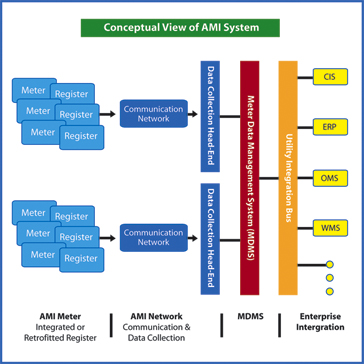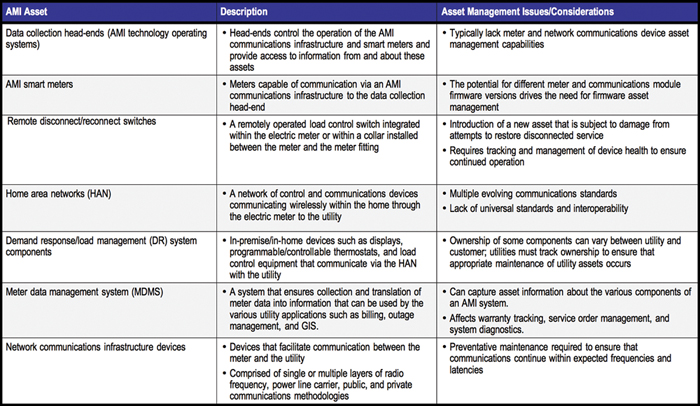
Asset Management for Advanced Metering Infrastructure
An Advanced Metering Infrastructure (AMI) system is comprised of a large volume of assets which include meters, modules, network communications infrastructure, and may also include remote disconnect/reconnect switches and demand response/load management (DR) system components (in-home displays, programmable/controllable thermostats, load control devices). When a utility implements AMI, they suddenly have millions of additional assets to manage. Many utilities’ workforces are not fully equipped to manage these new AMI assets.

Separating Metering and Billing
Advanced Metering Infrastructure promises transformational benefits across the utility enterprise. AMI is a pivotal information source that, used effectively, can drive efficiencies and benefits such as improved network and service reliability, increased revenue, increased profitability, and enhanced customer satisfaction.
As a simple example, AMI identifies meter failures via automated notification, allowing them to be addressed immediately rather than waiting for the next manual meter reading. Avoiding this delay minimizes the risk of lost or unbilled revenue and reduces the possibility of customer dissatisfaction with failed equipment.
Achieving and sustaining AMI benefits requires not only prudent planning of the AMI system but also proper management of the AMI system and system assets. Utilities can expect to spend multiple orders of magnitude more for an AMI system than they were spending on typical metering. With significantly longer payback periods, maximizing return on AMI investments is critical to ensuring achievement of the business case.
The discipline of asset management is designed to optimize asset use and manage all maintenance efforts involved in making assets as reliable, accurate, and efficient as possible. Utilities lacking an AMI asset management system run the risk of incurring significant additional, unexpected expense due to failed or poorly maintained equipment. For example, failure to proactively maintain the communications infrastructure of an AMI system may lead to unexpected failures and loss of communications to meters. If this occurs during a power outage, interruption duration and the cost of restoration will increase due to the lack of AMI-based information about the extent of the outage. If loss of communication occurs during a billing window, customers may receive estimated bills – a leading cause of customer dissatisfaction. This dissatisfaction often results in additional effort to investigate and resolve billing complaints.
How do AMI Assets Differ?
Utilities can’t manage their AMI system assets in the same way they manage their legacy meter assets, for three key reasons:
• Remote nature of automated meters
• Sophisticated communications infrastructure
• Enterprise-wide AMI system
Asset management of traditional meters is based on periodic testing and meter reader visits to the meter. AMI assets typically don’t require a physical visit by utility personnel. AMI meter readings are obtained remotely, disconnect/reconnect actions are executed remotely, and DR devices are controlled remotely. Rather than physical interaction with these devices, utilities rely on automated communications and data analysis to manage all of these assets. The availability of automated on-event and on-demand diagnostic data from an AMI system provides the opportunity for efficient and effective meter asset management.
AMI systems utilize a sophisticated communications infrastructure. Power line carrier, broadband over power line, and radio frequency communications require uniqueand often voluminous communications assets. Utilities have successfully managed communications infrastructure – mobile and LAN/WAN communications being an example. But AMI systems are more complex than typical communications infrastructure because they incorporate meters, additional network devices such as concentrators, relays, and/or take-out points, and head end data collection systems in addition to the communications infrastructure. AMI systems can also include in-premise, or in-home devices such as displays, smart thermostats, and load control equipment.
Unlike legacy meters, AMI is an integrated enterprise-wide system, and must be managed as such. Integration of AMI data through a meter data management system (MDMS) and a utility integration bus facilitateseasy communication of the data and information with utility applications such as billing, customer care, and system planning. AMI meter information (diagnostics and alarms) can be integrated with workforce management systems and included on work orders to allow field personnel to more efficiently address premise-related issues. Power outage and restoration information supplements customer reports of outages to enhance the efficiency of a utility outage management system. Supplemental data helps target the portions of a service territory impacted by the outage and the failed equipment causing the outage. Integrating AMI information into your geographic information system (GIS) allows for more efficient asset location and dispatch of field personnel.
Create a comprehensive asset management plan
A detailed, clearly-articulated plan must be developed that provides the framework for both proactive and reactive asset management. The asset management plan should clearly identify:
• Assets targeted for management. Assets range in volume and location depending on the AMI technology selected. While meters and modules are obvious elements to an AMI system, the communications infrastructure, demand side management devices, and operating system hardware and software can vary. The locations of these assets must be captured and maintained – a change for many utilities as metering location information isn’t typically tracked in a GIS system. Premise address information isn’t always an accurate or available method of locating assets.
• Measures necessary to assess the health of assets. AMI components have an expected operating life that can change depending on use and operation. Measures such as failed communications or number of remote disconnect operations completed can indicate the health of an asset and identify when a corrective action must occur.
• Proactive and reactive actions necessary to maintain the assets. Identification of health indices requiring action must be identified and the appropriate responses developed and documented. Proactive inspections of communications infrastructure ensure continued, efficient operation. Removal and analysis of failed meter assets can identify a meter population requiring immediate attention.
• Data necessary to calculate asset health measures. The AMI system isn’t the only source of AMI asset health information. Completed field work orders, such as meter investigations or revenue protection investigations, augment health indices. Distribution system reconfigurations or facility upgrades may change the locations of assets or the timeliness of asset management activity. Data from all appropriate sources must be utilized when assessing asset health.
• Repository to capture the data. The data from multiple sources must be made available in a single location to the organizations responsible for asset management.
• Tools and reports necessary to implement action. The data obtained from an AMI system must be converted into intelligent, actionable information.
• Organizations responsible for the assets. The appropriate organization must be identified and charged with the task of managing the AMI assets.
The asset management plan must be agreed to by all impacted organizations and communicated across the company.
Make the right organization responsible
Meter shop personnel have traditionally been tasked with managing meter assets. Sample and periodic testing, failure analysis and shop testing, and the resolution of failed meters are largely established processes. AMI systems, however, incorporate smart meters, home area networks, and the associated communications infrastructure. AMI systems are more complex than traditional metering and require a different skill set to manage and maintain. The ability of an organization to address all AMI assets, not just meters, is essential to successful AMI system asset management.
What organization should be responsible for managing this complex system? When implementing AMI, utilities typically build an organization responsible solely for the AMI system. This responsibility includes day-to-day operations, system maintenance, data management, and exception resolution. The AMI Team ensures that the AMI system operates as expected and delivers the data promised. This AMI Team should also be tasked with AMI asset management.
The AMI Team should include personnel whose expertise is distinct to each component of technology. Information Technology personnel are needed to manage the AMI Technology and MDMS operating systems. Meter personnel are needed to manage the electric meters and gas and water modules. Telecommunications personnel ensure that the communications infrastructure operates as expected. An exception management team resolves communications failures and data discrepancies and ensures resolution of billing issues.
The AMI Team will work with the appropriate field personnel to implement the asset
management plan for their areas of expertise.
Acquire the necessary data
The next step is to identify what data should be tracked for each system, to obtain the proactive and reactive data needed to determine asset management actions.
Collecting data about their AMI assets allows utilities to understand the assets and their performance. Device diagnostics, device operations, and age help identify, predict and determine the field activity necessary to maintain devices. Tracking and management of firmware versions is necessary to ensure that the latest functionality and diagnostics are available from each device. Service order histories provide valuable intelligence about the asset management history and help
identify potential asset issues. Without this overall view of AMI assets ? from diagnostic information on each asset to appropriate asset service histories ? utilities will not be able to make adequately informed asset decisions.
Data is both static and dynamic. Warranty and service level agreement (SLA) contract provisions result in key performance indicators (KPIs) that can be used to measure performance quantitatively. When implementing an AMI system, utilities should demand SLAs and warranty provisions to protect their AMI investment. In support of this, utilities must demand the data necessary to measure and track against these SLAs and associated KPIs.
While utilities are adept at capturing and storing data, utilities are not adept at converting multiple pieces of data into the information necessary to make asset related decisions. Utilities should consider the implementation of a new set of tools to assist with this effort.
Implement tools to turn data into information
To make intelligent, efficient, effective decisions regarding AMI system assets, utilities need tools that capture data from multiple sources and run analytics against that data. These analytics help facilitate the proactive and reactive management of assets.
Most utilities utilize some sort of asset management tool – typically intended for transmission and distribution assets. These existing asset management systems have not been designed to track and manage the distinct assets of an AMI system.
Most AMI technology operating systems (data collection head-ends) incorporate the tools to manage the communications infrastructure assets. Head-ends provide access to information about meters and communications infrastructure, but typically lack the detailed device and network management capabilities that are typically found in more mature industries like IT and data communications equipment management. Additional functionality is available from some of the commercial MDMS vendors, and some AMI systems are compatible with enterprise network management systems such as HP OpenView, IBM Tivoli, and CA UniCenter. In most cases these systems provide only reactive information and rely on periodic preventative maintenance in lieu of proactive or reliability-centered maintenance until systematic heuristics and the software to execute them is developed.

For example, most utilities rely on scheduled replacement of meter and module batteries to reduce the likelihood of failed operation due to a dead battery. These scheduled replacements often occur before the battery has reached the end of its useful life. The use of battery alarms captured by the head-end to determine the right time to replace batteries allows for the optimal use of this asset.
Over the 15-20 year life of an AMI system, a percentage of the meter and module population will fail and require replacement. New meters and modules typically incorporate the latest meter and communications module firmware. Unless all meters are upgraded with the latest versions of firmware as they become available, the meter population will contain varying versions of firmware. No AMI technology vendor currently has a solution for tracking and managing the multiple versions of firmware. Firmware configuration management has the potential to become a significant issue and should be a critical component of asset management.
Meter data management systems are designed to be the central hub for data obtained from the AMI system. The MDMS can capture asset information about the various components of an AMI system. An MDMS tracks the data about each component and affects warranty tracking, service order management, and system diagnostics.
An MDMS can also consider multiple sources of data when analyzing the need to manage an asset. A meter that experiences multiple momentary indicators (blink counts) may be an indicator of a meter issue. But it could also be an indicator of something else. The MDMS can utilize data from an outage management system to rule out reliability issues and data from a service order management system to rule out utility work already in progress at the premise. The MDMS can also review the history of the meter to identify potential trends in meter issues. The incorporation of multiple data sources into the MDMS analytics helps validate that a meter issue is really a meter issue and improve the efficiency of the work force managing assets.
Conclusion
Utilities are placing more and more emphasis on proactively managing non-AMI assets now – utilities should use this groundswell to promote the management of AMI system assets. AMI asset management improves the efficient and cost-effective operation of an AMI system and allows utilities to maximize the return on their significant investment.
About the Author
Jeff Evans is consultant and project manager with Enspiria Solutions, Inc. He supports utility clients across North America with Advanced Metering Infrastructure and Meter Data Management System development and implementation. Prior to joining Enspiria, Jeff spent 15 years with Exelon Energy Delivery, where he led various metering and AMI projects. Jeff holds a Masters of Business Administration and a Bachelor of Science in Mechanical Engineering.







